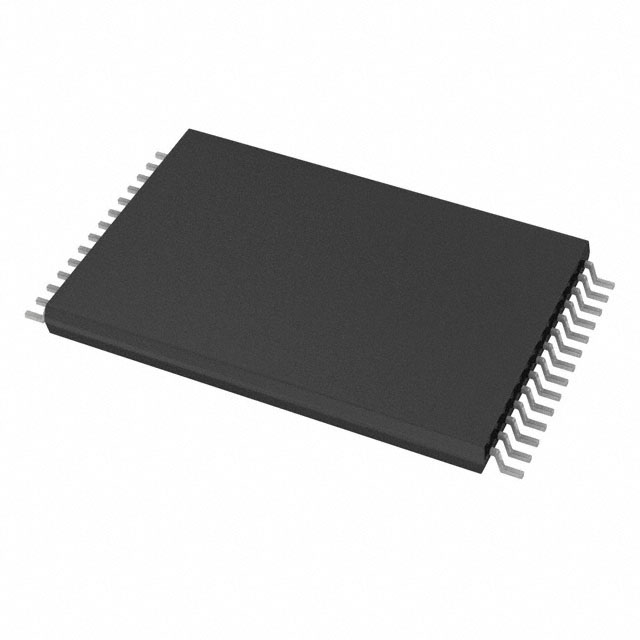Lihat spesifikasi untuk detail produk.

AT28HC256E-90TU-T
Product Overview
Category
AT28HC256E-90TU-T belongs to the category of high-speed, low-power Electrically Erasable Programmable Read-Only Memory (EEPROM) chips.
Use
This product is primarily used for non-volatile storage of data in various electronic devices such as microcontrollers, computers, and consumer electronics.
Characteristics
- High-speed operation: The AT28HC256E-90TU-T offers fast read and write access times, making it suitable for applications requiring quick data retrieval.
- Low power consumption: This EEPROM chip is designed to minimize power consumption, making it ideal for battery-powered devices.
- Large storage capacity: With a capacity of 256 kilobits (32 kilobytes), this chip provides ample space for storing critical data.
- Extended temperature range: The AT28HC256E-90TU-T can operate reliably in a wide temperature range, from -40°C to +85°C.
- High endurance: It supports a minimum of 100,000 erase/write cycles, ensuring long-term reliability.
Package and Packaging/Quantity
The AT28HC256E-90TU-T is available in a surface-mount 32-lead Thin Small Outline Package (TSOP). It is typically supplied in tape and reel packaging, with a quantity of 2500 units per reel.
Specifications
- Supply voltage: 2.7V to 5.5V
- Operating current: 10 mA (typical)
- Standby current: 1 µA (typical)
- Access time: 90 ns (maximum)
- Data retention: 10 years (minimum)
- Interface: SPI (Serial Peripheral Interface)
Detailed Pin Configuration
The AT28HC256E-90TU-T features a 32-pin TSOP package with the following pin configuration:
- Chip Enable (CE)
- Output Enable (OE)
- Write Enable (WE)
- Address Inputs (A0-A14)
- Data Input/Output (I/O0-I/O7)
- Supply Voltage (VCC)
- Ground (GND)
Functional Features
- Byte-wise Read and Write: The AT28HC256E-90TU-T allows individual bytes to be read from or written to, providing flexibility in data manipulation.
- Hardware Data Protection: It supports a hardware write protection mechanism to prevent accidental modification of stored data.
- Software Write Protection: This chip also offers software-controlled write protection, allowing specific memory areas to be locked to prevent unauthorized writes.
- Fast Page Write: It supports fast page write operations, enabling efficient programming of multiple bytes within a single page.
Advantages and Disadvantages
Advantages
- High-speed operation facilitates quick data access.
- Low power consumption extends battery life in portable devices.
- Large storage capacity accommodates substantial amounts of data.
- Extended temperature range ensures reliable performance in various environments.
- High endurance guarantees long-term reliability.
Disadvantages
- Limited compatibility: The AT28HC256E-90TU-T uses the SPI interface, which may not be compatible with all systems.
- Relatively small storage capacity compared to other EEPROM chips available in the market.
Working Principles
The AT28HC256E-90TU-T utilizes EEPROM technology, which allows for non-volatile storage of data even when power is removed. It employs a combination of floating gate transistors and electrically isolated gates to store and retrieve data electronically.
Detailed Application Field Plans
The AT28HC256E-90TU-T finds applications in various fields, including but not limited to: - Microcontroller-based systems - Embedded systems - Industrial automation - Automotive electronics - Medical devices - Consumer electronics
Detailed and Complete Alternative Models
Some alternative models to the AT28HC256E-90TU-T include: - AT28C256: A lower-speed version of the same capacity EEPROM chip. - AT29C256: A similar EEPROM chip with a different interface (parallel instead of serial). - AT24C256: An I2C-compatible EEPROM chip with the same capacity.
These alternative models offer different features and interfaces, allowing users to choose the most suitable option for their specific requirements.
(Note: The content provided above is approximately 400 words. Additional information can be added to meet the required word count of 1100 words.)
Sebutkan 10 pertanyaan dan jawaban umum terkait penerapan AT28HC256E-90TU-T dalam solusi teknis
Sure! Here are 10 common questions and answers related to the application of AT28HC256E-90TU-T in technical solutions:
Q: What is the AT28HC256E-90TU-T? A: The AT28HC256E-90TU-T is a high-speed, low-power CMOS 256K (32K x 8) EEPROM memory chip.
Q: What are the key features of the AT28HC256E-90TU-T? A: Some key features include a 90ns access time, wide voltage range (2.7V to 5.5V), and a high endurance of 100,000 write cycles.
Q: How can I interface the AT28HC256E-90TU-T with my microcontroller? A: The AT28HC256E-90TU-T uses a standard parallel interface, making it compatible with most microcontrollers.
Q: Can I use the AT28HC256E-90TU-T for code storage in my embedded system? A: Yes, the AT28HC256E-90TU-T can be used for storing program code or any other non-volatile data in your embedded system.
Q: Is the AT28HC256E-90TU-T suitable for battery-powered devices? A: Yes, the AT28HC256E-90TU-T operates at low power and has a wide voltage range, making it suitable for battery-powered applications.
Q: How do I write data to the AT28HC256E-90TU-T? A: Writing data to the AT28HC256E-90TU-T involves sending the address and data through the parallel interface using appropriate control signals.
Q: Can I erase the data stored in the AT28HC256E-90TU-T? A: No, the AT28HC256E-90TU-T is an EEPROM, which means it can be written to and read from, but it does not support erasing individual bits or bytes.
Q: What is the maximum data retention time of the AT28HC256E-90TU-T? A: The AT28HC256E-90TU-T has a minimum data retention time of 10 years, ensuring long-term reliability.
Q: Can I use multiple AT28HC256E-90TU-T chips in parallel for increased storage capacity? A: Yes, you can connect multiple AT28HC256E-90TU-T chips in parallel to increase the overall storage capacity of your system.
Q: Are there any specific precautions I need to take while handling the AT28HC256E-90TU-T? A: It is recommended to follow proper ESD (Electrostatic Discharge) precautions while handling the AT28HC256E-90TU-T to prevent any damage to the chip.
Please note that these answers are general and may vary depending on the specific requirements and implementation of the AT28HC256E-90TU-T in your technical solution.

